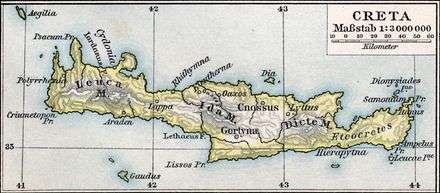Ancient Crete

Ancient Crete is the civilization that existed on the island of Crete, just south of Greece, in the Mediterranean Sea. From around 3560–1400 B.C., inhabitants known as Minoans controlled Crete and ruled the island in autonomous city states. Although the Minoans were able to rise to a position of political and economic dominance during this time, their civilization and subsequent control over Crete was destroyed by a large volcanic eruption 300 km away, layering it in hot volcanic ash. It is from this period onward that Crete began to fall under the control of the nearby Greek city-states and eventually the Roman Empire.[1]
Geography
The island of Crete runs approximately 260 kilometres (160 mi) in length from east to west and at its widest points in the center extends about 60 km. Crete is set in a region of the Mediterranean that is geologically unstable, and thus the island has been affected by countless earthquakes which have caused drastic shifts in the terrain and left many of its ancient cities in ruins. Findings of submerged cities and houses during archaeological diving expeditions just off the coast of Crete have allowed modern historians to assume that the Mediterranean Sea has risen since the time of the Minoans. The island is dominated by a mountain range known as the White Mountains which contain some peaks that reach approximately 2,500 metres (8,200 ft) in height.
Society
The Cretans are formally referred to as Minoans and formed what is considered as a civilized society around 2100 B.C. during the early years of the Bronze Age.[2] Much of what modern historians know about the Minoans comes from Linear B which was discovered at the palace of Knossos.[3] The tablet was translated and contained lists of inventory that is assumed to have been stored in the palace. Since the period when the Mycenaeans first inhabited the island of Crete they were ruled by a monarchy.[4] There was no official capital of Crete, as each city-state was independent, but Knossos was the de facto ruler of the region. It is unclear as to what type of taxes were paid by the surrounding villagers to the crown, yet it is most likely that these people paid in tribute by providing goods and manufactured products. As stated earlier in the article the Mycenaeans did participate heavily in Mediterranean trade. Though many resources were available for the Mycenaeans on the island of Crete, there was always a constant demand for olive oil and grain (such as wheat) which were found inland in nearby Greece.[5] Each city-state located within Crete had two integral parts of its structure: an acropolis and an agora (marketplace). The acropolis was usually built atop a mountain to help defend it from invaders, while the public agora resided in the valley below. There is evidence to suggest that many Minoan city-states also practiced sports, such as boxing and bull jumping (see below in Religion).
Religion
Evidence that the Mycenaeans had a set polytheistic religion is plentiful throughout several architectural remains on Crete. Evidence suggest that instead of temples, the Ancient Cretans worshipped in groves of trees. These figurines depict the Ancient Cretan gods and weakly resemble the familiar gods depicted in Greek mythology.[6] Like in the worship of Greek mythology, the practice of both supplication and sacrifice seem to be prevalent in the Mycenaean cults. Most areas of worship contain altars and statues where both of these procedures could be performed.[2] Minoan art shows strong evidence of the reverence of women in Minoan practices (see Minoan civilization#Language and writing). The Minoans often depicted women as wearing flowing skirts, having long and dark hair, and sometimes breasts being exposed. Women are also depicted with very white skin, suggesting they may have been excluded from many of the jobs men had to do outside. The dark hair seen in these figures supports a theory that the Minoans were of Persian descent, but this has not yet been proven. In many depictions, women are seen holding snakes in each hand, but this practice remains a mystery. There is also evidence found in pottery and murals of the act of bull jumping, which was often performed by young men and women as a rite of passage (see Minoan civilization#Language and writing). Every year, Knossos would demand seven young men and women leave home to compete in bull jumping tournaments, and the survivors would be allowed to inhabit Knossos for the remainder of their days. This custom was partially the basis for a novel by Suzanne Collins, The Hunger Games.[7] Bull jumping is also believed to be the origin of modern gymnastics.[8] Bull jumping as well as Minoans often depicted holding their arms up in 90-degree angles suggest the reverence of Taurus, or the sacred bull. This also gave rise to the popular Mycenaean story of the Minotaur, a half-man half-bull beast said to inhabit the city of Knossos, which was shaped like a labyrinth.[9]
Any actual mythological stories or true beliefs within the Cretan religion remain a mystery to most historians. This is due to the lack in archaeological remains which were so crucial to understanding both Greek and Roman mythology.
References
- ↑ Willetts, R.F., The Civilization of Ancient Crete, 1992, pp. 21–37
- 1 2 Warren, P., "The Aegean Civilizations", 1997, pp. 33–34
- ↑ Warren, P., "The Aegean Civilizations", 1997, pp. 24–25
- ↑ Schofield, L., "The Mycenaeans", 2007, pp. 66–67
- ↑ Spyridakis, S.V., "Cretica", 1992, pp. 123
- ↑ Willetts, R.F., The Civilization of Ancient Crete, 1992, pp. 461–72
- ↑ GradeSaver. "The Hunger Games The story of Theseus and the Minotaur". Retrieved 16 March 2016.
- ↑ "A History of Gymnastics: From Ancient Greece to Modern Times". Scholastic Teachers. Retrieved 16 March 2016.
- ↑ "MINOTAUR : Bull-headed man of the Labyrinth of Crete, labor Theseus ; Greek mythology ; pictures : MINOTAUROS". Retrieved 16 March 2016.